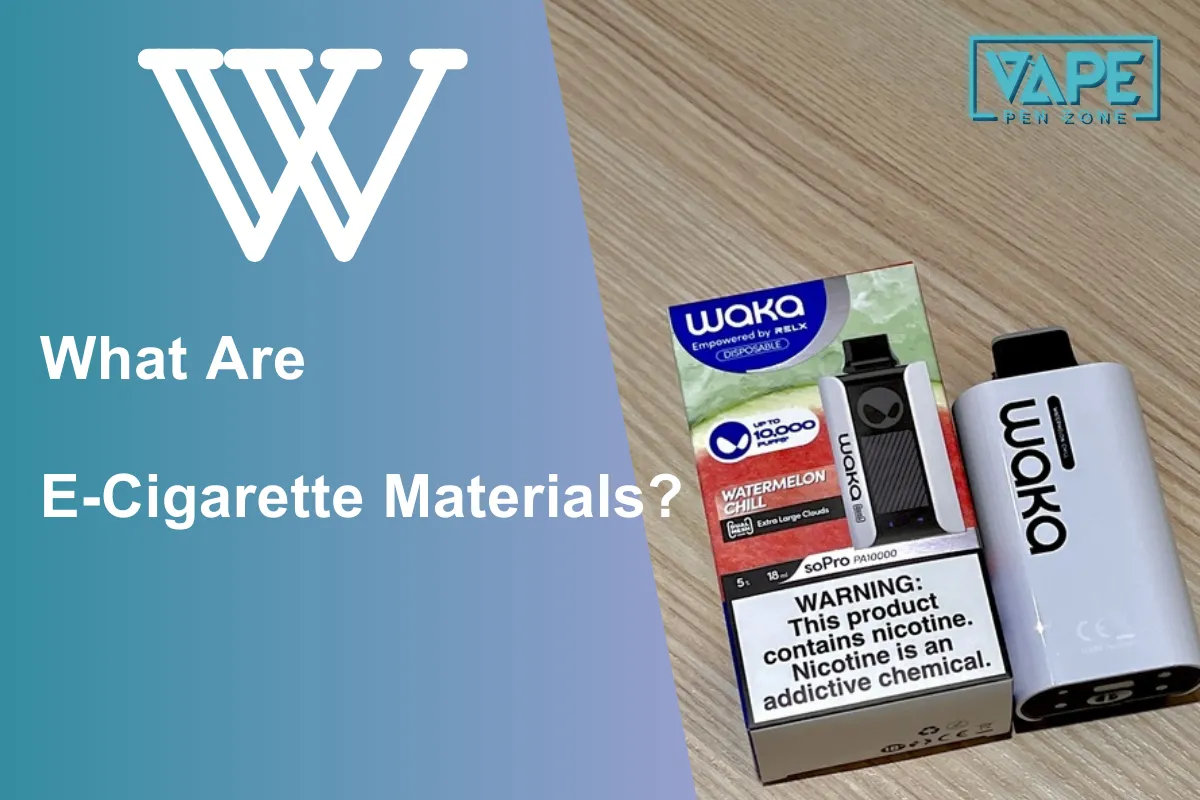Introduction
E-cigarette materials make up the complete e-cigarette. These materials are integral to providing the smoking experience. This article will introduce the detailed materials and ingredients of e-cigarettes.
E-Cigarette
Electronic cigarettes, e-cigarettes, also known as vapes, are electronic devices whose aim is to provide a similar sensation to smoking without the combustion of tobacco, which is known to release harmful chemicals.
They differ from traditional e-cigarettes in that they are portable and customizable, and rechargeable e-cigarettes can be recycled and reused. They are typically made up of several key materials and components below.
E-Cigarette Device Components
- Battery: This powers the device and is usually rechargeable. It’s the component that provides energy to heat the coil, and its key function is to determine how long you can use it.
- Atomizer: This heats the e-liquid, usually a coil made of metal like Kanthal, stainless steel, or nichrome, turning the liquid into an inhalable aerosol.
- Tank or Cartridge: This holds the e-liquid. Cartridges might be disposable or refillable, while tanks are typically refillable and can vary in size.
- Coil and Mouthpiece: The mouthpiece, typically made of plastic or metal, is where the user inhales the vapour. It can be part of the cartridge or a separate attachment.
- Microprocessor and Sensors: Some advanced e-cigarettes are equipped with microprocessors for regulating power and may include sensors that control the heating element based on airflow.
- LED Indicator: It is common for LED lights to be designed for use in e-cigarettes, which light up when the user takes a puff. This usually mimics the glow of burning tobacco in a traditional cigarette.
- Charging Port: The charging port in e-cigarettes is typically a micro USB or a similar interface that allows users to recharge the device’s battery. This standard port allows users to recharge their e-cigarettes using common charging cables.
- Circuitry: The circuitry plays a crucial role in ensuring the device operates safely and efficiently, preventing issues like overheating, overcharging, and short circuits that could potentially lead to safety hazards.
An e-cigarette works like this: first, the battery powers the device, and then the atomizer and its coils and wicks heat the e-liquid. The tank or cartridge stores the e-liquid. Lastly, the mouthpiece is your connection to the e-cigarette.
E-Liquid Composition
E-liquid or vape juice is the core ingredient of electronic cigarettes. It is generally composed of propylene glycol (PG), vegetable glycerin (VG), flavourings and nicotine, which are optional for vapers.
- Propylene Glycol (PG): This is thinner and provides a stronger throat hit. It carries flavours well and is often preferred for those who want a more intense flavour and a sensation similar to smoking.
- Vegetable Glycerin (VG): It’s thicker and contributes to vapour production. E-liquids with higher VG content tend to produce thicker vapour clouds and can provide a smoother hit.
E-Cigarette Materials Used
E-cigarette devices are usually made of stainless steel, various plastics, glass, and sometimes ceramics. These materials are very friendly to e-cigarette devices and help improve the device’s durability, functionality and safety.
Stainless Steel: Often used for the structural components, including the casing, tanks, and some of the internal parts due to its durability and resistance to corrosion.
Pyrex or Glass: Utilized in some tanks for holding the e-liquid. Glass is preferred for its inert nature, meaning it doesn’t react with the e-liquid.
Plastics: Sometimes found in constructing mouthpieces, drip tips, and the outer casings of certain devices.
Silicone: Used in seals and gaskets to prevent leakage and ensure airtight connections in some models.
Ceramics: Occasionally incorporated in heating elements or coils for better heat distribution and longevity.
Rubber or O-rings: These are used in seals and connections to prevent leakage and maintain a secure fit between various components.
Verdict
If you’re a smoker, it’s important to know about e-cigarette materials. E-cigarette materials are crucial to the smoking experience, especially in customizable devices.
Checking for reputable manufacturers, understanding the composition of materials, and being aware of any potential risks associated with modifications are key for users looking to personalize their vaping experience safely.
E-Cigarette Materials FAQ
What type of chemicals are in e-cigarettes?
E-cigarettes contain various chemicals, propylene glycol (PG) and vegetable glycerin (VG), flavourings, nicotine and trace chemicals.
What metal is in e-cigarettes?
E-cigarettes typically contain various metals, primarily in their construction and components like nickel, nichrome, kanthal, and stainless steel.
Are e-cigarettes made of plastic?
Yes, e-cigarettes often include plastic components in their construction.
What are the product ingredients that are found in an e-cigarette?
E-cigarettes primarily contain the following ingredients: e-liquid or vape juice consists of propylene glycol (PG), vegetable glycerin (VG), flavourings and nicotine. What’s more, there are metals and plastic.
